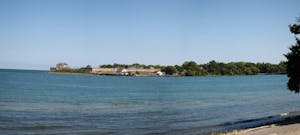Best Places in Niagara Falls for a History Buff

Sightseeing in Niagara Falls
If you’re thinking about doing any sightseeing in Niagara Falls, you might envision waterfalls and river rapids rather than historic sites. But the Niagara region has some of Ontario’s most well-preserved heritage landmarks and they are some of the best places in Niagara Falls and its surrounding area, so a day trip to Niagara Falls from Toronto has an abundance to offer history lovers. In this blog, we lay out some of the top attractions to add to any history-focused Niagara Falls sightseeing itinerary.
Want to visit Niagara but don’t have access to smartphone data? Check out our blog on how to download Google Maps so you can easily navigate offline while you explore!
Niagara-on-the-Lake: Ontario’s only National Historic District
Whereas there are many places to visit in Niagara Falls known for their natural beauty, thirty minutes up the road is a town that’s truly not to be missed if you love history and want to do some memorable sightseeing in Niagara Falls and the surrounding region. Niagara-on-the-Lake has preserved much of its 19th-century character, with many of its buildings dating back to the mid-1800s—making a walk through its historic district feel very much like a stroll through an old British colonial town.
The community has done such a good job at protecting its built heritage that the federal government made it a National Historic District, the only one currently in Ontario, meaning the most popular activity in town is to simply wander its tree-lined streets to appreciate its beauty and charm.
If you’d like to more formally learn about the town’s past, you can check out the small Niagara-on-the-Lake Museum and their claim to fame, Sir Isaac Brock’s hat. Brock was a general during the War of 1812 (more information on him below) who died in 1812 during a major battle nearby. The hat was en route from Europe at the time, so he never actually wore it; nevertheless, if you do visit the museum you’ll notice the hat looks decidedly well used. During his many internment ceremonies after his death (learn why he had more than one below), the hat was always placed on his coffin and many attendees tried it on—leaving a brand-new hat looking considerably worse for wear!
There are a ton of high-activity places to visit in Niagara Falls and Niagara-on-the-Lake, but to take advantage of a tranquil moment and enjoy a quiet break from all your Niagara Falls sightseeing, you can sit on the shore of Lake Ontario at Niagara-on-the-Lake’s Queen’s Royal Park. Across the water you’ll see a large stone fort. Located in New York, that’s called Fort Niagara, and was the major American base of operations during the War of 1812.

The view across the water at Queen’s Royal Park.
Fort George
The British defenses, meanwhile, were at a stronghold called Fort George (51 Queen’s Parade), a short drive or fifteen-minute walk from Niagara-on-the-Lake’s townsite, and it’s one of the best places to visit in Niagara Falls for military history aficionados. The Niagara region is famous for its role during the War of 1812, so a history-focused Niagara Falls sightseeing tour is naturally going to highlight a few places devoted to this major conflict. Fort George National Historic Site is a reconstruction of the principle British fort on the Canadian side. When it’s open, the fort has costumed staff who recreate the lives of the soldiers and their families who would’ve been stationed here over 200 years ago.
From the fort, you can see the Niagara River and the United States, and recognize how close the opposing British and American sides were during the war. Due in no small part to this proximity, however, prior to the outbreak of the conflict people on both sides of the border got along well—intermarrying, trading, and becoming friends.
As an indication of how close they were, would you like to guess where the American officers stationed at Fort Niagara were when they learned they were at war with the British? Being entertained by British officers at Fort George. Essentially, a messenger came into the mess hall as the officers from the two forts were eating, and passed the message to the British commanding officer letting them know he was now at war with his dinner guests.
As you can imagine, the news caused just a bit of a stir. But the commanding officer stood up, looked at the men in the room and said, “Gentlemen, there is no need to let bad news ruin a good dinner”, and the evening carried on. After supper, the British and American officers walked down to the river where boats were waiting to row the Americans back to Fort Niagara, they shook hands all around and wished each other well, and from that moment on, they were at war.
Laura Secord Homestead
From Niagara-on-the-Lake, continue your sightseeing in Niagara Falls tour by heading to the Laura Secord Homestead (29 Queenston St. in Queenston). In 1813 during the War of 1812, US troops took control of Niagara so the British retreated, but fifty British soldiers stayed behind to make life difficult for the opposing troops in any way they could.
The Americans discovered the British hideout and plan an attack, but just days before they carry it out, a few soldiers patrolling the town get a little thirsty, so they knock on the door of a local townsperson named Laura Secord and ask for something to drink. As they sit around her table, they begin chatting about what’s going to happen.
By the time they’re finished, they’ve talked through the entire plan, with Laura hearing every word. As soon as they’re gone, she rushes upstairs to her bedridden husband, and they decide to warn the British. Because her husband can’t walk, Laura needs to go, and at 3:00 AM the next morning, she sets off. For eighteen hours she tramples through the forest and by nightfall she’s gone 32 kilometres—about twenty miles—to arrive at the English camp where she alerts the commander who can prepare his defence and save his men.
To help recognize Laura’s heroics, in the 1960s her original homestead was turned into a seasonal museum. If it’s open, you’re welcome to take a break from your Niagara Falls sightseeing itinerary to stop in and learn more about Laura and her family. It’s one of the best places in Niagara Falls to hear about the social history of the area. Up on the second floor you’ll also see photos of all Laura’s children: Laura, Hannah, Mary, Charles, Charlotte, Appolonia, and Harriet. Does one of those names kind of seem slightly unlike the others? In the late 1700s explorers had discovered Pompeii, so there was a big revival among British society in interest in Greco-Roman history. As with many parents back then, Secord and her husband named one of their children Appolonia after the Greek god Apollo, to show they were trendy.
Brock’s Monument
Isaac Brock is the other major War of 1812 hero honoured in Niagara, and his huge monument is just up the road (14184 Niagara River Parkway). Under his guidance, less than a month after the war started the British captured Fort Mackinac in Michigan and a few weeks later Brock’s vastly-outnumbered redcoats also captured Detroit. Later that year, the General was killed while valiantly defending Niagara during the Battle of Queenston Heights that took place where Brock’s Monument is today. It was his bravery and leadership in those early days of the war that secured his reputation as a hero worthy of one of the largest war memorials in Canada.
Would you like to guess how many times Isaac Brock’s been buried? Not once, not twice, not even three times; beneath his monument is his fourth—and hopefully final—resting place. After the Battle of Queenston Heights the British interred General Brock inside Fort George, but a decade later decided he deserved a hero’s burial beneath a new war memorial. So in 1824 they brought him to Queenston Heights and buried him beneath the first Isaac Brock Memorial.
Unfortunately, in 1840 an anti-British protestor set off an explosive charge near the base of the monument, causing irreparable damage. Brock’s body was exhumed and reburied in the nearby Hamilton Burying Ground while the current column was under construction, and in 1853 was brought back to Queenston Heights, buried for a fourth time, and he lies beneath the memorial to this day.
Niagara Parks Power Station
Carrying on your journey will soon take you to the sites of Niagara Falls itself. Niagara Falls is certainly more famous for its natural attractions than its history, but of all the places to visit in Niagara Falls townsite, the most interesting from a heritage perspective is the Niagara Parks Power Station. This electrical generating station is a new addition to the Niagara Falls sightseeing roster, opening in 2022. For a century, it harnessed the power of Horseshoe Falls to generate electricity, but in 2006, they closed the doors and preserved everything almost exactly as it was.
Recently refurbished, they’ve reopened the power station as a historic site where you can learn all about its role as well as the broader history of generating power for Canadians and Americans at Niagara Falls.
Have you heard of Nikola Tesla? The famous inventor is famously associated with the modern alternating current electricity supply system we still use today. He never made it to Canada, but did work right across the river at Niagara Falls, New York, and his presence is certainly found in the power station: Nine of his inventions are present, including the huge AC generators in the middle of the main floor.
The Niagara Parks Power Station is an exact copy of the American power station on the other side of the Niagara River, where Tesla worked. The American building has been stripped, however, so the Canadian one is the only one left that gives you a sense of the power plant where Tesla would’ve strolled around, inspecting his inventions and helping to bring electricity to tens of thousands of people.
While we’ve done our best to suggest our favourite historic attractions to help you build a great day trip itinerary, we’d encourage even the most devoted history buff to also explore the natural beauty of the majestic Niagara waterfalls, so if you’d like to learn more about the best places in Niagara Falls to enjoy these stunning natural attractions, check out our blog post here.
We hope you have a blast exploring one of the most beautiful, and historically-fascinating, parts of Ontario!
